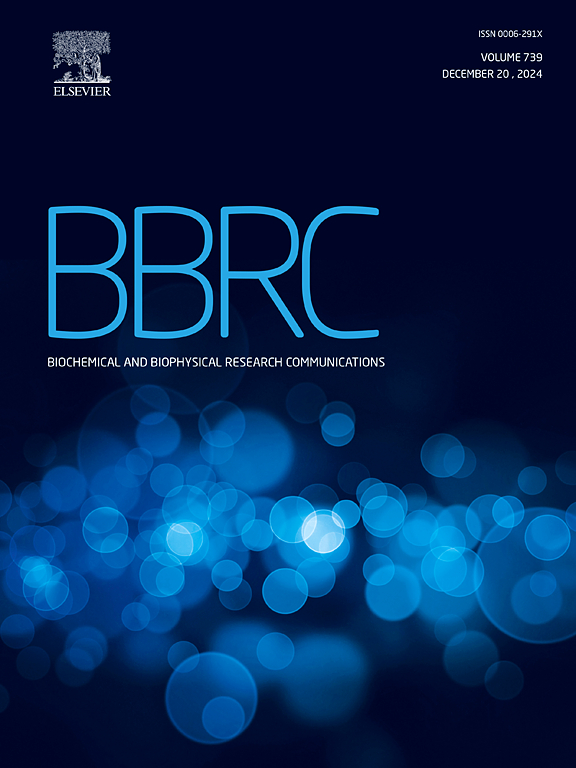Intravesical chemotherapy enhances anti-tumor immunity in bladder cancer by modulating CD8+ T cell activation and Treg populations
IF 2.5
3区 生物学
Q3 BIOCHEMISTRY & MOLECULAR BIOLOGY
Biochemical and biophysical research communications
Pub Date : 2025-04-09
DOI:10.1016/j.bbrc.2025.151782
引用次数: 0
Abstract
Bladder cancer is one of the most common malignancies of the urinary system, with standard treatments including surgery, radiotherapy, and chemotherapy. However, these conventional approaches often yield suboptimal outcomes, necessitating exploring alternative therapeutic strategies. This study evaluated the efficacy of intravesical chemotherapy, both alone and in combination with immunotherapy, using an orthotopic mouse model of bladder cancer.
To establish the model, luciferase-expressing bladder cancer cells were orthotopically implanted into immunocompetent mice. Treatment efficacy was assessed by monitoring changes in bioluminescence imaging (BLI) signal intensity, indicative of tumor burden, and by measuring tumor weights post-mortem. Mice were divided into four groups: G1: untreated control; G2: intravesical chemotherapy with 40 mph Doxorubicin (0.05 ml per mouse, bladder instillation); G3intraperitoneal (i.p.) chemotherapy with 10 mph Doxorubicin; G4: immune combination therapy with 10 mph Doxorubicin (i.p.) plus 10 mph PD-L1 inhibitor (i.p.).
Results demonstrated that intravesical chemotherapy significantly reduced tumor burden compared to both conventional systemic chemotherapy and immune combination therapy (p-value <0.05). Flow cytometry analysis revealed a notable decrease in CD8+ T cell expression in both the intravesical and conventional chemotherapy groups (p value < 0.01). Additionally, Treg cell expression was moderately reduced in the conventional and immune combination therapy groups (p value < 0.05). Notably, intravesical chemotherapy led to a significant increase in CD69 activation on CD8+ T cells (p value < 0.05), suggesting enhanced T cell activation, while also moderately reducing PD-1 expression, a marker of T cell exhaustion (p value < 0.05).Histological analysis, including hematoxylin and eosin (HE) staining and Ki-67 immunohistochemistry, further confirmed significant differences in tumor morphology and proliferation among the treatment groups (p value < 0.05). These findings suggest that intravesical chemotherapy not only exerts a direct anti-tumor effect but also modulates the immune response by activating CD8+ T cells and mitigating T cell exhaustion.
To conclusion, this study highlights the potential of intravesical chemotherapy as a promising and clinically feasible approach for bladder cancer treatment, warranting further investigation in translational and clinical practice.
膀胱内化疗通过调节CD8+ T细胞激活和Treg群增强膀胱癌的抗肿瘤免疫
膀胱癌是泌尿系统最常见的恶性肿瘤之一,标准治疗方法包括手术、放疗和化疗。然而,这些传统的方法往往产生不理想的结果,有必要探索替代治疗策略。本研究使用原位膀胱癌小鼠模型评估膀胱内化疗的疗效,无论是单独化疗还是联合免疫治疗。为了建立模型,将表达荧光素酶的膀胱癌细胞原位植入免疫功能小鼠体内。通过监测生物发光成像(BLI)信号强度的变化来评估治疗效果,指示肿瘤负荷,并在死后测量肿瘤重量。小鼠分为四组:G1:未治疗对照组;G2: 40mph阿霉素膀胱内化疗(0.05 ml /只小鼠,膀胱灌注);g3腹腔注射10mph阿霉素化疗;G4:免疫联合治疗10 mph阿霉素(i.p.)加10 mph PD-L1抑制剂(i.p.)。结果表明,与常规全身化疗和免疫联合治疗相比,膀胱内化疗显著减轻了肿瘤负荷(p值<;0.05)。流式细胞术分析显示,膀胱内化疗组和常规化疗组CD8+ T细胞表达均显著降低(p值<;0.01)。此外,常规治疗组和免疫联合治疗组Treg细胞表达轻度降低(p值<;0.05)。值得注意的是,膀胱内化疗导致CD8+ T细胞的CD69活化显著增加(p值<;0.05),提示T细胞活化增强,同时适度降低T细胞衰竭标志物PD-1的表达(p值<;0.05)。组织病理学分析,包括苏木精和伊红(HE)染色和Ki-67免疫组织化学,进一步证实了治疗组之间肿瘤形态和增殖的显著差异(p值<;0.05)。这些发现表明,膀胱内化疗不仅具有直接的抗肿瘤作用,而且通过激活CD8+ T细胞和减轻T细胞衰竭来调节免疫反应。总之,本研究强调了膀胱内化疗作为一种有希望且临床可行的膀胱癌治疗方法的潜力,值得在转化和临床实践中进一步研究。
本文章由计算机程序翻译,如有差异,请以英文原文为准。
求助全文
约1分钟内获得全文
求助全文
来源期刊
CiteScore
6.10
自引率
0.00%
发文量
1400
审稿时长
14 days
期刊介绍:
Biochemical and Biophysical Research Communications is the premier international journal devoted to the very rapid dissemination of timely and significant experimental results in diverse fields of biological research. The development of the "Breakthroughs and Views" section brings the minireview format to the journal, and issues often contain collections of special interest manuscripts. BBRC is published weekly (52 issues/year).Research Areas now include: Biochemistry; biophysics; cell biology; developmental biology; immunology
; molecular biology; neurobiology; plant biology and proteomics

 求助内容:
求助内容: 应助结果提醒方式:
应助结果提醒方式:


